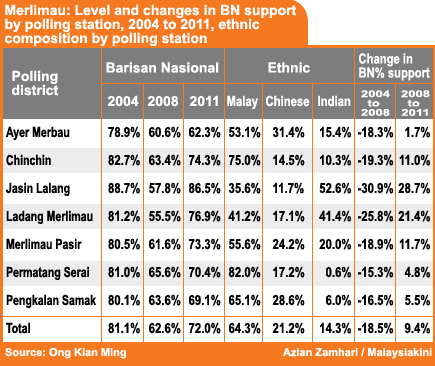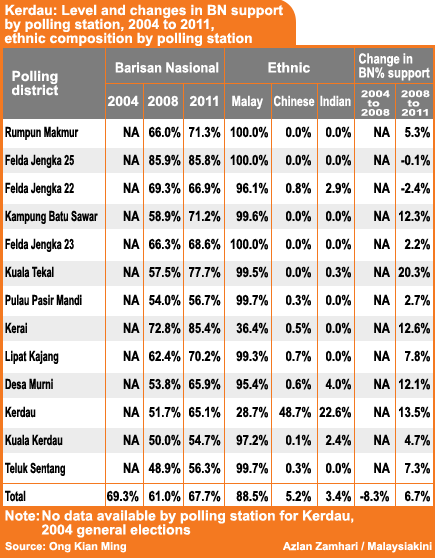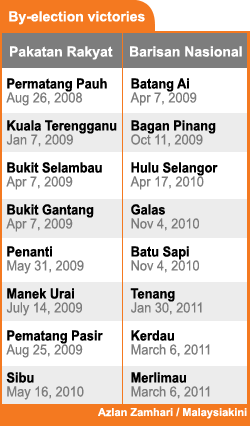ANALYSIS What can we make of the Merlimau and Kerdau by-elections four days after the results were announced? The results were not surprising. Most analysts, including me, had predicted that the BN would win by a bigger majority in both seats.
My prediction of a 4,000-vote majority for the BN in Merlimau was off by 357 votes (3,643 was the eventual majority) and my prediction of a 2,500-vote majority for the BN in Kerdau was off by 224 votes (2,724 was the eventual majority).
As is customary after each by-election, I want to examine the detailed results to find out where I went wrong and where I went right, and then proceed to discuss the implications of the findings.
Merlimau
I begin with Merlimau. I had predicted swings of approximately 6% (Malay), 5% (Chinese) and 45% (Indian) to BN, giving the ruling coalition 74% of the total vote and a 4,000-vote majority.
The eventual share of BN’s vote was 72%, which provided a majority of 3,643 votes. As stated in my prediction piece, because of the relatively even distribution of the non-Malay vote across the seven polling stations in this seat, it is difficult to estimate BN’s share of the vote by ethnic group using data at the polling station or poling stream levels.
Instead, I try to draw conclusions based on the levels and changes in the level of BN support by polling station.
Table 1 shows the levels and changes in the levels of BN support in each of the seven polling stations in Merlimau. It also shows the ethnic composition of each polling station.

A few points are worth noting. Firstly, the polling stations with the largest swings in the level of BN support from 2004 to 2008 are also the polling stations with the largest swings from 2008 to 2011.
These two polling stations - Jasin Lalang and Ladang Merlimau - are also the polling stations with a high percentage of Indian voters - 52.6% and 42.4% respectively.
A polling station which is 50% Indian, a 10% swing in the level of Indian support for the BN will translate into a 5% swing in the total BN support in that polling station.
In a polling station like Jasin Lala, which is 53% Indian, the almost 30% swing in the level of BN support indicates an Indian swing of 50% to 60%, much higher than the 45% I projected in my prediction piece.
The same can be said of Ladang Merlimau, with 40% of Indian voters and a 21% vote swing in BN’s favour.
Little movement among the Chinese
The level of BN support among the Chinese in Merlimau is harder to discern because of the even distribution of Chinese voters across the polling stations.
My best guess, based on the polling stations with more than 15% Chinese and with relatively few Indian voters - Permatang Serai and Pengkalan Samak - and based on Ayer Merbau - the polling station with 31% of Chinese voters, the highest in Merlimau - is that of a small swing back to the BN of 1% to 2%.
This is because the increase in BN’s share of the vote in all three polling stations were relatively small. (In fact, one can make the argument that BN’s share of the Chinese vote in Ayer Merbau actually decreased slightly). Certainly, my projection of a 5% swing in the Chinese vote is higher than the actual increase in this by-election.
If the Indian support for BN is estimated to have swung 50% to 60%, and if the Chinese vote swing back to BN was 1% to 2%, we can estimate that the remaining Malay vote swing back to the BN was approximately 3%, half of the 6% I predicted.
An increase in the Malay, Chinese and Indian vote of approximately 3%, 1% and 50% respectively gives us the Malay, Chinese and Indian support levels for BN at 74%, 61% and 82% respectively, delivering slightly over 72% of the popular vote and a vote majority of slightly under 3,700 votes, not far from the actual results.
Kerdau
In Kerdau, BN’s share of popular vote increased to 67.7% from 61% in 2008 and the BN’s majority increased from 1,615 to 2,724.
In an almost 90% Malay-majority seat, an almost 7% increase in BN’s share of the total vote reflects a similar increase in BN’s share of the Malay vote. This is not far off from my estimate of a 6% increase in the share of Malay votes for this seat.
According to Table 2, the increase in BN’s share of the popular vote in the only non-Malay majority polling station - Kerdau - was 13.5%. This increase is consistent with an increase in the Malay (6%), Chinese (10%) and Indian (20%) support for BN in this polling station. The increase in the BN’s share of Chinese support of 10% is higher than my prediction of 5%.

Another interesting point to note is that the percentage of BN support in the three Felda Jengka areas did not shift significantly from 2008.
In fact, BN support actually decreased slightly in Felda Jengka 25 and 22, which is surprising given the supposed commitment offered by BN to solve some of the outstanding Felda issues. Indeed, the increase in BN’s share of the popular vote was far greater in some of the non-Felda Malay majority areas.
Finally, even though the BN’s winning majority of 2,724 votes surpassed its 2004 majority of 2,565, one must take note that BN’s share of the total vote, at 67.7%, is less than the 69.3% it achieved in 2004.
The larger majority is reflective of the increase in the number of voters from 2004 to 2010 of approximately 10%.
Implications
What then are the implications of these two by-elections?
 Firstly, the consistent trend of the shift in the Malay vote back to the BN since March 2008 has not changed significantly. The exceptions were the by-elections in Kuala Terengganu and Permatang Pauh. A nationwide swing of approximately 5% in the Malay support for the BN would not be surprising if a general election were to be called now.
Firstly, the consistent trend of the shift in the Malay vote back to the BN since March 2008 has not changed significantly. The exceptions were the by-elections in Kuala Terengganu and Permatang Pauh. A nationwide swing of approximately 5% in the Malay support for the BN would not be surprising if a general election were to be called now.
Secondly, the swing in the Indian vote back to the BN, which is a more recent phenomenon, continues to pick up steam. Depending on the magnitude of the swing from 2004 to 2008, the expected swing in the Indian support for the BN could be anywhere from 20% to 50%.
Thirdly, the Chinese vote is swinging back to the BN, albeit in small numbers, especially in the semi-rural areas in which the DAP does not have a strong presence.
All these factors lead to the inexorable conclusion that if a general election were to be called now, the BN would probably regain its two-thirds majority, assuming that the status quo remains in Sabah and Sarawak.
But Najib cannot call a snap general election just yet because of uncertainty over the outcomes in Sarawak and because he needs more time to deliver on his economic and political promises, most notably through the Government Transformation Programme (GTP) and the Economic Transformation Programme (ETP) to ensure that the benefits of these programmes become more tangible on the ground across the different states in Peninsular and East Malaysia.
Sarawak key to Pakatan’s revival
PAS and to a lesser extent, PKR, are currently feeling the pressure to find means to stop the bleeding among the Malay electorate. PAS will inevitably feel the pressure to use Islamic issues, and a non-inclusive manner, to achieve this goal while PKR may find it necessary to dial back some of the rhetoric on replacing the NEP with a more needs based economic policy.
 This will inevitably form part of the backdrop of the PAS party elections and I would not be surprised if certain PAS leaders were to push for a more aggressive and explicit policy to promote the ‘Islamic agenda’ within the context of Pakatan.
This will inevitably form part of the backdrop of the PAS party elections and I would not be surprised if certain PAS leaders were to push for a more aggressive and explicit policy to promote the ‘Islamic agenda’ within the context of Pakatan.
Pakatan best hope of regaining its lost political momentum lies not in Peninsular Malaysia but in Sarawak, where state elections are anticipated sometime in April or May this year. If somehow, the BN can be denied a two-thirds majority in Sarawak, some of the political pressure within Pakatan to use less inclusive means of campaigning would be lifted.
The focus of the opposition, in many ways, had already shifted to Sarawak prior to these two by-elections. BN’s celebrations too were relatively short lived as the ruling coalition prepares for what will be a very intense and political significant battle in the land of the hornbill.
ONG KIAN MING holds a PhD in political science from Duke University. He is currently pioneering a Master in Public Policy (MPP) programme at UCSI University. He can be reached at [email protected].

